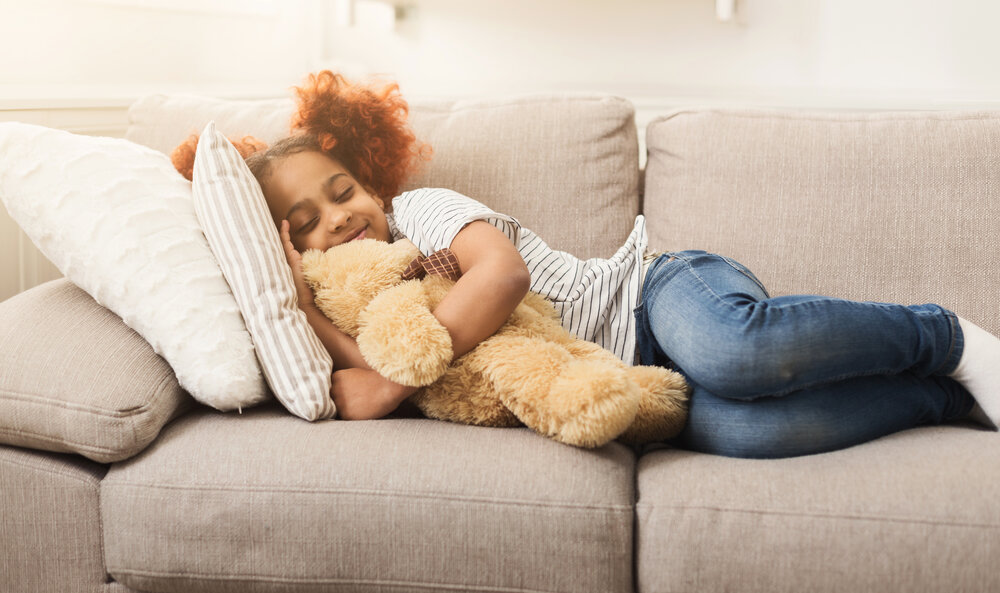
Calming Techniques for Kids with Anxiety, According to a Clinical Psychologist
Feelings can be overwhelming sometimes, especially for children who haven’t learned how to react and respond to them. Managing emotions, even more so during stressful situations, can be difficult regardless of age. This is especially true when routines are disrupted. Routines play a key role in promoting feelings of safety and security in children. When boundaries are broken, they can feel more vulnerable and unsettled.
One of the challenges as a parent is learning how to teach our children to handle negative emotions in a positive way, rather than trying to always prevent our kids from ever getting upset. It’s important for kids to learn appropriate ways of responding when feeling overwhelmed so that they are able to manage emotional stress as an adult more effectively. Calming techniques and guided meditations for kids can help them connect with what they’re feeling and work through these strong emotions.
The moment we become stressed or upset our bodies become tense. Our heart rate rises and our breathing becomes more shallow and difficult. When our bodies are calm, we are in a restful state. We breathe normally, our muscles are relaxed and our heart rate is lower.
To support you and your child during challenging moments of anxiety or stress, here are some relaxation and calming tips from clinical psychologist Dr. Azizi Seixas and the Moshi team.
Calming techniques for kids
Deep Breathing
Taking long deep breaths sends signals to your body that it’s time to slow down. When we feel anxious, stressed, or upset our breathing naturally becomes more rapid and shallow. By simply slowing down our breathing, the feeling of being ‘out of control’ gradually dissipates.
Moshi has a new feature designed specifically for children learning the practice of deep breathing. With a soothing guiding voice and peaceful illustrations, kids are able to follow SleepyPaws and other Moshlings whilst they breathe deeply. Their bodies will be in a more restful state in no time.
Positive Thinking
Positive words and thoughts can go a long way when it comes to changing your outlook on stressful or upsetting situations. To help your little one deal with strong emotions centered around a certain event or challenge, help them replace their negative thoughts with positive ones. Encourage them to say positive phrases. For example, ‘I can do this,’ or ‘this will not last forever’. This is great for when you talk with them about their concerns or anxieties and will create a more positive growth mindset about the problem. In turn, can help shine a brighter light on an issue that may seem daunting and overwhelming.
According to clinical psychologist, Dr. Azizi Seixas, it is important to help kids see imperfections, challenges, bad experiences and setbacks as positive learning experiences that get better over time with the help of loved ones. This will help kids learn how to cope with emotions and challenges, develop grit, and discover how to tap into their own psychological resources as well as resources around them. They’ll also learn the age-old axiom, there will be good days and bad days, but the good days will outnumber the bad.
If you’d like to learn more about how to start positive thinking with your kids, check out our blog Grateful Living with Little Ones.
Thought Stopping
Another strategy of Dr. Azizi’s that has proven helpful is that of thought stopping. Thought stopping occurs when you help your child identify negative and anxious thoughts before they snowball. Help your child to recognize when they have negative thoughts and help them disprove or manage them. For example, if your child is anxious about a math exam because they think that they will never be good at math, you can help them disprove this idea by showing them that they are good with numeric concepts in other enjoyable settings and scenarios. For example, playing cashier in a make-believe shop.
Finding Distracting Activities
Help kids respond to anxiety by developing a routine filled with fun activities that they enjoy. Try coloring, a physical activity, sports or playing games. These activities will enable them to focus on things other than their worrying thoughts. Parents can help their kids establish an activity routine and safe location. Eventually, they will engage with this space by themselves as they become familiar with it over time.
Physical Comfort
People find physical comfort very calming because of a chemical being released in our brains called oxytocin, also known as the ‘cuddle hormone.’ The release of this cuddle hormone causes a reduction in blood pressure and norepinephrine, our stress hormone. This can run the gamut from snuggling to a simple weighted blanket.
Guided Meditations
Meditation is known as one of the most well-known ways of relaxing the body. This is why it’s a great calming technique for kids! It can be difficult for kids to settle their bodies and minds, especially when distraught. This is why guided meditations can be beneficial. Visualizing a calm and safe space allows our bodies to slow down and enter a more restful and controlled state.
Moshi has curated playlists, meditations, relaxations and other content specifically designed to help reduce stress and anxiety.
For example, Moshi Moments are short but impactful guided meditations specifically for children. They are designed for moments when they need help managing their emotions. Soothing narration guides them through simple techniques, such as positive thinking and focusing on melodic sounds while taking long deep breaths. This allows them to imagine the stressful world around them fading away